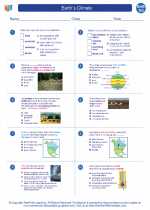Sunspots
Sunspots are temporary phenomena on the Sun's photosphere that appear as dark spots compared to surrounding areas. They are caused by interactions with the Sun's magnetic field and are cooler than the surrounding surface, hence they appear darker.
Causes of Sunspots
Sunspots are caused by the Sun's magnetic activity. The Sun's magnetic field is constantly changing and can become twisted and distorted, leading to the formation of sunspots. The number of sunspots on the Sun also follows a regular cycle known as the solar cycle, which lasts approximately 11 years.
Characteristics of Sunspots
Sunspots are darker than the surrounding areas on the Sun's surface because they are cooler. They can vary in size and often occur in pairs or groups. The number of sunspots on the Sun increases and decreases in a cyclic pattern known as the solar cycle.
Study Guide
- What are sunspots and how do they appear on the Sun's surface?
- Explain the causes of sunspots and the role of the Sun's magnetic field in their formation.
- Describe the characteristics of sunspots and their relationship to the solar cycle.
- Discuss the significance of studying sunspots and their potential impact on Earth.
- Compare and contrast sunspots with other solar phenomena such as solar flares and prominences.
Impact on Earth
Studying sunspots is important as they can have a direct impact on Earth. The solar activity associated with sunspots can cause disruptions to satellite communications, power grids, and navigation systems. Additionally, the increased solar radiation during periods of high sunspot activity can affect Earth's climate and contribute to the phenomenon known as the solar cycle.
Understanding the behavior of sunspots and the solar cycle is crucial for space weather forecasting and mitigating potential impacts on Earth's technology and climate.
Remember to study the causes, characteristics, and impacts of sunspots, as well as their relationship to the solar cycle, to gain a comprehensive understanding of this fascinating solar phenomenon.
.◂Earth Science Worksheets and Study Guides High School. Earth`s Climate

 Worksheet/Answer key
Worksheet/Answer key
 Worksheet/Answer key
Worksheet/Answer key
 Vocabulary/Answer key
Vocabulary/Answer key
 Vocabulary/Answer key
Vocabulary/Answer key
 Vocabulary/Answer key
Vocabulary/Answer key
